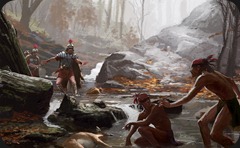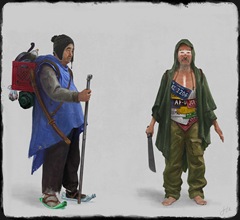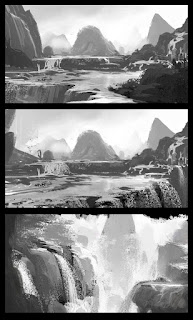Wednesday, July 1, 2015
Environmental Design
here's a quick environmental scene of power generators on a waterfall I did this week-about 6-7 hours total, most of which was spent doing alot of little value sketches such as these:
it's always interesting to me switching from thinking about composition, staging, and lighting to rendering. You can almost feel the dfferent parts of your brain working.
Monday, March 9, 2015
Monday Paintover: Tommaso Gomez and the rule of thirds
And now for my last paint over from the IDEA Academy workshop, the work of Tommaso Gomez, a longtime industry vet and a great all around artist, as you can see from his environmental study (and website)
Since Tommaso's painting is technically quite sharp, for this post I'll focus a bit more on composition in service of storytelling-this is an area that even seasoned pros can always work on- myself included. Tommaso's piece shows us a castle high up on a mountain ridge and the there's alot to like in the piece- the division and distribution of light and dark shapes is terrific and the light is working nicely.
At this point I would turn my attention to figuring out what this scene is all about- is this the fortress of some evil ruler? or a peaceful kingdom? or an ancient ruin? To help to find these answers, I want to first do a couple subtle adjustments so that we can lead the eye where we want it to go.
Much of art theory is about leading the viewer's eye through the placement of elements in the scene. One of the simplest compositional guides is known as the Rule of Thirds, in which you divide the canvas into thirds vertically and horizontally, and the areas of interest should be close to the intersections. This is a principle that has been used by classical painters and film makers alike, and it's a good starting point for concept artists as well.
As we can see on Tomasso's scene, the castle is just a bit high and right, which can cause the viewer to linger in other places rather than the focal areas
To address this I'm going to move the castle area slightly. I'm also going to add a secondary area of interest lower on the page ( near the lower left focal area ) to give the eye another opportunity to learn more about this scene. Using the Rule of Thirds is especially useful to convey a sense of balance and stability which is something which seems appropriate to the scene.
In addition to those changes, I'm also lightening the darks of the castle and some other areas to increase the distance and scale- notice we basically have 3-4 levels of distances ( see the previous paintover for more on that ) We could even continue creating a literal path leading the eye from the lower structure to the higher one to guide the eye up.
Now that the elements are framed more prominently, we are free to consider more what the scene is about- for example, if this is a tranquil scene showing a peaceful mountaintop monastery, we can introduce a warm light and some birds to create a nice establishing shot.
As always, the choices I've made here are not necessarily the 'best' ones- ultimately it's up to you to decide to fill in the story, and that will guide your choices. happy painting!
Monday, March 2, 2015
March Paintover: Studies in Grey
Hey guys, sorry for the long absence but the last two months have been pretty busy! Fortunately I'm back on track and I've got two crits left from our workshop! And first up is a very quick paintover for Stephania from the IDEA Academy workshop.
Before that I wanted to talk a bit about working in greyscale. When I first starting drawing and painting at the college level, my teachers had us working only in charcoal. This tradition goes back to the earliest art academies, where it was taught ( and still is ) that painting is 90% drawing. The result of working in grayscale is that you develop a strong sense of depth and graphic patterns without the distraction of color. Above is one of my charcoal pieces where I was very much concerned from the beginning with the interplay of light and dark shapes
turning now to our next paintover, I see that Stephania 's environmental sketch could benefit from some value adjustment. The first thing to do is simply to turn down the saturation to see how this looks without the color ( note: this is not a 100% accurate way to see your values, but for our purposes it's close enough ).
As you can see, everything is kind of sitting in the middle gray range, so the quickest thing is to simply push the values lighter or darker- and the most basic way to do that is to use atmospheric perspective ( the tendency of objects to have more contrast as they get closer to the eye )
Now, the different shapes are distinct from each other and sit in a space which make some kind of sense. This makes things much easier to 'read' visually, and sets you up to start breaking up the big shapes to take it to the level of render that you have in mind
As always, I recommend starting with big simple shapes ( much of this I'm creating by simply using the selection tool ). Rending beyond this state is simply a matter of breaking the shapes into smaller and more precise shapes. Even the addition of some simple gradients also help to define the space better
So that's it for this lesson- I highly recommend going out and doing some value studies-I may do some myself!
Before that I wanted to talk a bit about working in greyscale. When I first starting drawing and painting at the college level, my teachers had us working only in charcoal. This tradition goes back to the earliest art academies, where it was taught ( and still is ) that painting is 90% drawing. The result of working in grayscale is that you develop a strong sense of depth and graphic patterns without the distraction of color. Above is one of my charcoal pieces where I was very much concerned from the beginning with the interplay of light and dark shapes
turning now to our next paintover, I see that Stephania 's environmental sketch could benefit from some value adjustment. The first thing to do is simply to turn down the saturation to see how this looks without the color ( note: this is not a 100% accurate way to see your values, but for our purposes it's close enough ).
As you can see, everything is kind of sitting in the middle gray range, so the quickest thing is to simply push the values lighter or darker- and the most basic way to do that is to use atmospheric perspective ( the tendency of objects to have more contrast as they get closer to the eye )
Now, the different shapes are distinct from each other and sit in a space which make some kind of sense. This makes things much easier to 'read' visually, and sets you up to start breaking up the big shapes to take it to the level of render that you have in mind
As always, I recommend starting with big simple shapes ( much of this I'm creating by simply using the selection tool ). Rending beyond this state is simply a matter of breaking the shapes into smaller and more precise shapes. Even the addition of some simple gradients also help to define the space better
So that's it for this lesson- I highly recommend going out and doing some value studies-I may do some myself!
Subscribe to:
Posts (Atom)

























